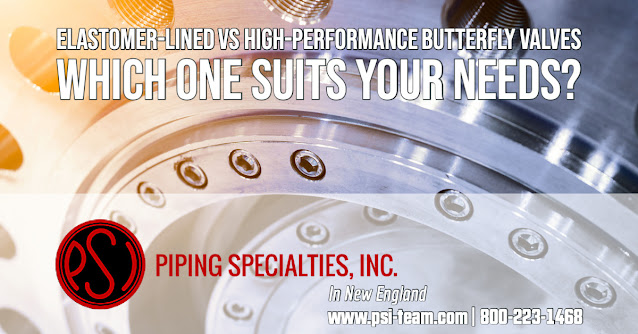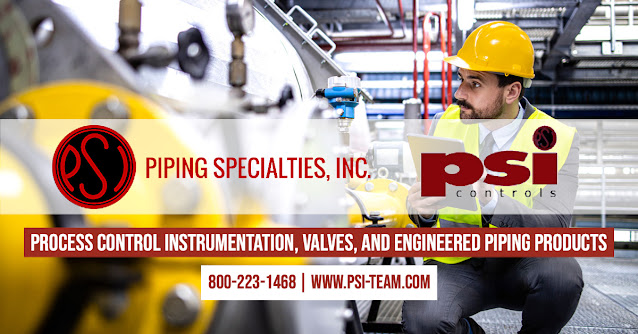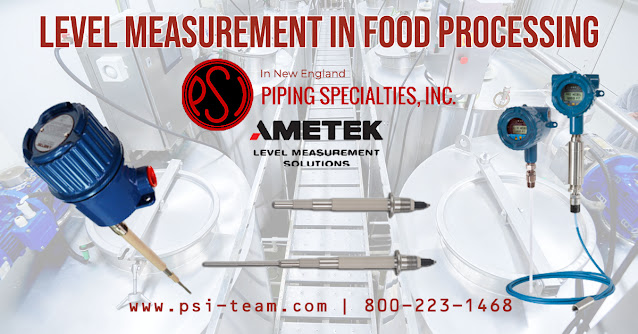Piping Specialties Inc. (PSI) is one of the northeast's largest suppliers of valves; process controls/instrumentation, and engineered mechanical specialties. Industries served: Power Generation, Pulp/Paper, HVAC, Water/Wastewater, Food/Beverage, Life Sciences, Chemical/ Process, Semiconductor. For more information visit PSI-Team.com or call 800-223-1468.
Advanced Water Level Monitoring in Sewage Pools
Elastomer-Lined vs High-Performance Butterfly Valves: Which One Suits Your Needs?
- Water Treatment Plants: In water treatment plants, operators often use these valves to throttle service, control flow rate, or as on-off valves.
- Chemical Industry: These valves frequently appear in the chemical industry, where they handle mildly corrosive substances or fluids with small amounts of solid content. They control the flow of various chemical products in pipelines.
- HVAC Systems: Heating, ventilation, and air conditioning (HVAC) systems employ these valves to regulate the flow of chilled or heated water.
- Food & Beverage Industry: The food and beverage industry uses these valves to maintain sanitary conditions, thanks to their ability to handle gentle cleaning and sterilization procedures.
- Oil & Gas Industry: The oil and gas industry widely uses high-performance butterfly valves due to their ability to withstand higher pressures and temperatures. They control the flow of oil or gas in pipelines and processing equipment.
- Power Generation: Power plants use them, especially in steam and feed water lines, where high temperatures and pressures are typical.
- Chemical Plants: Chemical plants also use these valves to handle aggressive chemicals at higher temperatures and pressures.
Plugged Chute Detection Technology: The Superiority of RF Admittance
The operation of industrial processes is a delicate balance of efficiency, safety, and maintenance. A crucial part of maintaining this balance is ensuring the smooth operation of material handling systems, which often employ chutes to transport bulk materials. One common complication these systems face is the problem of chute blockages or plugging, a critical issue that can lead to costly downtime, equipment damage, and potential safety hazards.
Plugged chute detection technologies mitigate these challenges, offering early detection and warning of chute blockages. However, the effectiveness of these technologies varies, and understanding their characteristics is essential for making an informed decision.
Overview of Plugged Chute Detection Technologies
Plugged chute detection technologies fall into three broadly classified groups, mechanical, acoustic, and electromagnetic methods.
Mechanical systems, such as tilt switches and paddle wheel indicators, are simple and inexpensive but prone to mechanical failure and false alarms due to vibration or material buildup. They also require regular maintenance to function effectively.
Acoustic detectors, on the other hand, utilize microphones to listen for changes in the acoustic signature of material flow. While this can be an effective method, it is sensitive to environmental noise and requires sophisticated signal processing to distinguish between normal and blocked flow.
Electromagnetic methods include capacitive probes, microwave radar, and RF Admittance. These offer non-contact detection and are less prone to false alarms and mechanical failures—however, the material's properties, environmental conditions, and installation setup affect their performance and application.
RF Admittance: The Optimal Choice
After an extensive review of these technologies, RF Admittance emerges as the overall best selection for plugged chute detection for several reasons:
Reliability
RF Admittance technology uses a probe to measure changes in the dielectric constant (a property of materials that affects their response to an electric field) between the sensor and the chute wall. When the chute is clear, the admittance (the measure of how easily a circuit or device allows an electric current to pass) between the probe and chute wall will be at one level, and when the chute is blocked, the admittance will change significantly. This reliable detection method leads to fewer false alarms than mechanical and acoustic systems.
Resistance to Material Buildup
One of the significant advantages of RF Admittance technology is its resistance to material buildup on the probe. The technology uses a driven shield construction that ensures only the material near the active sensor affects the reading. This feature helps to eliminate the risk of false alarms due to material buildup, a common issue in other technologies.
Versatility
RF Admittance technology works with various materials, regardless of their conductive or non-conductive properties, making it a versatile solution in different industries handling multiple types of bulk materials.
The Drexelbrook Solution
The Drexelbrook Plugged Chute Detector consistently identifies whether material is flowing through chutes. If the material ceases to flow due to a blockage, an alarm from the flush-mounted capacitance sensing element will be triggered, prompting further necessary actions such as notifying an operator or shutting down a conveyor belt.
The Drexelbrook detector, also known as a blocked chute switch, reliably tracks the presence or absence of bulk solids material in chutes without compromising flow speed. This cost-effective device ensures the continuous flow of materials.
Its robust sensor design makes this point-level switch optimal for handling materials such as coal, wood chips, ores, and powders. Since it is flush mounted through a chute wall, there is no protrusion into the chute to hinder or obstruct material flow.
The point-level switch can automatically identify and disregard coatings, thus preventing false alarms. It features a universal power supply that auto-detects and adjusts to the input power source.
Unlike similar technologies, the point-level switch for detecting plugged chutes permits remote electronics installation at a convenient or safer location.
The dependable detection of plugged chutes ensures smooth plant operations and significantly reduces the chance of spills due to blockages.
Key Features:
- Availability of both curved and flat sensors
- DPDT relay dry contacts rated at 5A, 120VAC
- Requires less maintenance compared to other technologies; devoid of any moving parts that could potentially hang up or wear out
- Utilizes Drexelbrook PML series electronics
- Auto-detecting supply voltage range: 19-250 VAC, 18-200 VDC, without the need for jumpers
Delivering Process Control Excellence in New England: The Piping Specialties/PSI Controls Advantage
Piping Specialties, Inc. / PSI Controls is a highly regarded process equipment Rep and Distributor with offices in Portland, Maine, and Danvers, Massachusetts. The products they specify, apply, and sell, including process control instrumentation, industrial valves, actuators, and engineered piping products, are vital for the process control industries of New England.
About Piping Specialties/PSI Controls Territory
New England comprises six states: Connecticut, Rhode Island, Massachusetts, Vermont, New Hampshire, Upstate New York, and Maine. The primary process industries in these states include:
- Manufacturing: Manufacturing is a significant sector in New England, including the manufacturing of machinery, electronic products, biomedical and pharmaceutical products, plastics, and rubber products.
- Food Processing: New England is known for its dairy, seafood, and specialty foods. Dairy processing is significant in Vermont, while seafood processing is prevalent in coastal states like Massachusetts and Maine. There is also a strong presence of craft breweries, wineries, and distilleries.
- Biotechnology and Pharmaceuticals: The biotechnology and pharmaceutical industries are prominent in this region, particularly in Massachusetts, home to many biotech and pharmaceutical companies.
- Microelectronics and Computer Hardware: States like Massachusetts and Connecticut have a strong microelectronics and computer hardware sector, including the manufacturing of semiconductors.
- Chemicals: The chemical industry, including specialty chemicals, industrial gases, and coatings, is also prevalent in this region.
- Energy: While not a traditional "process" industry, the energy sector, including renewable energy technologies, nuclear energy, and conventional power generation, is also significant in New England.
PSI's mission is to ensure the smooth operation of these vital sectors by offering the highest quality products backed by their expert services.
Outstanding Pre and Post Sales Engineering Support
PSI Sales Engineers bring tremendous value to their customer in New England in several crucial ways:
- Technical Expertise: PSI sales professionals know about instrumentation, valves, and other process control equipment. They can help customers understand the benefits and functionalities of different products, enabling them to make informed purchasing decisions that best meet their requirements.
- Customer Needs Analysis: PSI Sales Engineers are skilled at understanding and interpreting customer needs. They can suggest suitable products or tailor-made solutions that will meet a customer's specific needs, ensuring optimal performance and return on investment.
- Customer Education: PSI sales people are pivotal in training customers on adequately using and maintaining equipment, enhancing customer satisfaction and loyalty. This education ensures that the instruments and valves operate at peak efficiency and can prolong their life cycle and minimize downtime.
- Troubleshooting and Support: PSI Sales Engineers often provide technical support, helping to solve any problems customers may encounter with the equipment. Their ability to troubleshoot issues quickly can significantly impact customer satisfaction and retention.
Call Piping Specialties/PSI Controls with Your Next Instrumentation, Valve, or Engineered Piping Requirement
PSI takes pride in their deep industry knowledge, technical expertise, and customer-centric approach, enabling them to tailor their offerings to match our customers' needs. PSI strives to continuously provide reliable, efficient, and safe solutions, reinforcing their commitment to their customers and the broader industry.
Piping Specialties, Inc.
https://psi-team.com
800-223-1468
The Emerson TESCOM™ Anderson Greenwood H2 Series for Hydrogen Applications and Fuel Stations
Level Measurement in the Food Processing Industry
Level sensors and controls are crucial in industrial food processing and production facilities to ensure quality and consistency. These devices monitor and regulate the level of liquids, solids, or granular materials in containers, vessels, or silos. Here are some of the most common types of level sensors and controls used in the industry:
- Capacitive level sensors: These sensors detect changes in capacitance caused by the presence or absence of material (liquid or solid) in a container. They measure liquids, powders, or granular materials levels in various applications, including food and beverages.
- Ultrasonic level sensors: Ultrasonic sensors use sound waves to measure the distance between the sensor and the material's surface. These sensors are non-contact and used for measuring levels of liquids or solids in tanks or silos and provide the food industry with accuracy and reliability.
- Radar level sensors: Similar to ultrasonic sensors, radar level sensors use radio waves to measure the distance between the sensor and the material's surface. They are also non-contact and suitable for liquid and solid materials. Radar sensors are particularly useful in challenging environments with dust, vapor, or foam, making them ideal for food processing applications.
- Hydrostatic pressure level sensors: These sensors measure the pressure exerted by the liquid column on the sensor at a specific depth. The pressure re-calibrates to a level measurement. They are primarily used for measuring liquid levels in tanks and have broad use in the food and beverage industry.
- Float level sensors: Float sensors use a floating device to detect the liquid level in a container. The float's vertical or tilting movement triggers a mechanical or electrical signal indicating the liquid level. Food processing plants often use them for simple and cost-effective level measurements.
- Vibrating or tuning fork level sensors: These sensors use a vibrating probe or tuning fork that changes its vibration frequency when it comes into contact with a material. They can detect the presence or absence of material and provide point-level detection of liquids, powders, or granular materials.
- Optical level sensors: Optical sensors use infrared or visible light to detect the presence or absence of a material at a specific level. They are suitable for various materials, including liquids, powders, and solids, in food processing applications where minimum contact with the material is essential.
The choice of level sensor and control system depends on factors like the process material, the required accuracy, the process conditions, and the specific application within the food processing facility. Each technology has advantages and limitations, so careful consideration is needed to select the most suitable option for each application.






